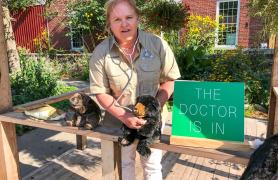When I became the ninth director of the Missouri Department of Conservation, I knew I had big shoes to fill. Undoubtedly, there have been lots of conservation giants pushing this department forward over the past 80 years, including brilliant scientific minds and innovative leaders. Their ability to effectively plan for the long-term through scientific research, public input, and sustained conservation funding has been pivotal to our success. We are now facing new 21st century conservation challenges, such as invasive species and wildlife diseases, that need our immediate
attention and resources.
On my first day as director, I began working with our talented staff and dedicated partners on our new strategic plan. We began to develop from the ground up a road map for the next five years with input from hundreds of staff, volunteers, partners, and citizens from all over the state. We asked some tough questions.
Is there a better way to deliver conservation? How do we get there in a constantly changing world with finite conservation resources? How do we ensure that conservation of fish, forest, and wildlife resources stays relevant to the people already engaged while also reaching new people with limited exposure to the outdoors? What’s our plan of action, step by step and year by year? And, equally important, how will we measure our success?
This road map, though far from perfect and always a work in progress, has the answers to some of those questions, including how we will live out our mission to conserve the fish, forest, and wildlife resources in Missouri and provide outdoor recreation opportunities across the state.
In this plan, called Missouri Conservation: Design for the Future, there are four big goals, 14 equally ambitious outcomes, and hundreds of targeted objectives — all with champions and teams pushing them forward and measurements tracking progress along the way.
While I’m so proud of all the work we’ve already done, the hard work continues as we put this plan into action starting this month. There is one thing I know for sure — we cannot do it alone. We need every citizen, partner, volunteer, and MDC employee helping us keep conservation front and center in Missouri. Our citizens have always been a key part of conservation — from the creation of the department 80 years ago to securing our dedicated funding to ensure we keep moving forward.
To all of you, thank you for being the best part of our story!
Sara Parker Pauley, Director
The Past Speaks Loudly and Eloquently
In the August 1975 issue of Missouri Conservationist, MDC’s new Design for Conservation clearly outlined how the dedicated conservation sales tax dollars, being voted on the November 1976 ballot, would be prioritized to push conservation forward in Missouri. It so eloquently stated, “Design for Conservation is a plan to mitigate the relentless scrape and crunch of development. It is a chance for all Missourians to share in the safeguarding of a historic outdoor heritage. Heritage is something passed along. How sad if all we pass to those who will remember us is noise and pollution and concrete. How sad never to hear the sweet voice of a bluebird, never to see the dogwoods in bloom, never to know the majesty of an oak-mantled Ozark bluff. That is sorrow we must not allow to occur in the tomorrow of our future.”
The information outlined a strategic approach on how to safeguard that outdoor heritage in Missouri. It included conservation land acquisition; development of wetlands; preserving natural areas and endangered species; increasing state forests and stream access; construction and operation of hatcheries; wildlife, aquatic, and forest research management services; law enforcement; information programs, including outreach and education; conservation education services, such as nature centers; enhancement of our great rivers’ borders; and wildfire control.
These long lists of items have been priorities for MDC for the past 40 years. While many of these are ongoing each year, such as multiple-year scientific research studies and assistance to Missouri landowners, there are others that have been completed, thanks to the innovative thinking and longterm planning of this earlier strategic conservation plan. These include the construction of new hatcheries, wetland areas, and nature centers and interpretive sites around the state. In October, the Springfield Conservation Nature Center will be celebrating its 30-year anniversary of connecting people with nature and helping them learn the importance of conserving it, too.
Missouri continues to be on the conservation forefront, both as a statewide and national conservation leader, but also faces some daunting challenges, including new wildlife diseases, fastspreading invasive species, and people disconnected from the outdoors. How do we build on the solid foundation and success of the Design for Conservation? We keep the strong foundation, but continue to refine, regroup, and rebuild better ways to deliver conservation today and tomorrow.
Refining, Regrouping, and Rebuilding for the Future
Last year, as MDC celebrated 80 years with open houses around the state, staff collected citizen input to shape a new strategic plan. We asked, how are we doing? What are your thoughts on our regulations and infrastructure? What are your priority conservation topics? Most importantly, how can we partner with you to keep getting better? We alsoasked our staff and more than 100 partners the same questions. What emerged was a refined and rebuilt road map for the future.
Missouri Conservation: Design for the Future outlines priorities for the next five years from July 2018–June 2023. During that time, we will continue to include a high level of citizen participation, feedback, and measurement of conservation success while directing our efforts to the highest conservation priorities in a rapidly changing world. Our challenges include resource related issues that will impact wildlife, land, and water, but also include big challenges we face as a society, such as a majority of people residing in urban areas and growing increasingly disconnected from nature. Driving our strategic approach to conservation is the realization that, as challenges evolve, so must our approach and methods for engaging the next generation of conservationists.
Our answer to these challenges is built on a foundation of operational excellence, which is made possible by our world-class staff, prioritizing the most important work in the most important places through strategic conservation, and delivering superior customer service. The focus on operational excellence also includes improving the business side of conservation to continue to be efficient, effective, and excellent stewards of Missouri taxpayer dollars.
Outlined in our five-year plan is an effort to strategically prioritize the most pressing conservation work for the state of Missouri. MDC’s strategic framework ensures our finite financial resources are invested in the most important conservation opportunities, including taking care of our current conservation footprint, for the enjoyment of current and future generations. While our plan will continue to evolve, we are striving to make the vision outlined on these pages a reality in the coming years. That is our commitment to you.
Goal 1: Sustain and Improve Fish, Forest, and Wildlife
What we are working toward
Healthy and resilient populations of fish and wildlife, and the natural habitats that support them
How we will deliver
- Prioritize restoration efforts in places where we can get the most results for our efforts
- Manage invasive species and disease
- Practice active land management
- Work with partners to improve the ecological functions of watersheds
- Conduct scientifically sound research
- Recover threatened and endangered species
People, Partners, and Pollinators
The drastic decline of the monarch has spurred conservation action in Missouri and across the U.S. MDC has a unique partnership with more than 30 agencies and organizations on a monarch collaborative and pollinator conservation plan in Missouri. The Missourians for Monarchs collaborative has agribusiness, conservation organizations, academia, state and federal agencies, volunteer groups, and agriculture associations all working together on an aggressive goal of establishing more than 19,000 acres of pollinator habitat per year in Missouri.
Goal 2: Enhance the Relevance of Conservation
What we are working toward
Missourians value and take action for conservation, and participate in nature-related activities and recreation
How we will deliver
- Establish and strengthen partnerships
- Provide conservation information to the public
- Engage citizen input in regulatory decisions
- Take a community policing approach to law enforcement
- Help private landowners and local communities manage their natural resources
- Empower volunteers and citizen scientists
- Deliver a variety of educational programs
Creative City Partnership Creates New Green Space
A partnership between MDC, the Green City Coalition Project, the City of St. Louis, the Mayor’s Office, the St. Louis Sewer District, the Missouri Botanical Gardens, and other conservation partners is helping this urban St. Louis core think creatively about green space. There are more than 60 miles in inner city St. Louis where houses have become run down and abandoned over the years. As these uninhabitable houses are being torn down, partners are working together to make it a viable and productive green space with native plants to help pollinators. It is also a tremendous benefit to people, including their physical and emotional health, to have trees, native plants, and green space in the neighborhoods that they walk and drive by every day. This unique partnership has worked together on 80 properties so far with 1,000 more on the horizon.
Goal 3: Connect Citizens With Fish, Forest, and wildlife Resources
What we are working toward
People have both physical and virtual places to go to enjoy and learn about nature
How we will deliver
- Increase people’s access to outdoor recreation opportunities near where they live
- Offer a range of conservation lands and facilities
- Use technology to connect people to conservation information and improve program delivery
Exploring Nature With Technology
MDC’s nearly 1,000 conservation areas cover close to 1 million public acres to conserve the fish, forest, and wildlife resources in Missouri, but also to provide opportunities for all citizens to use these resources. Most Missourians are within a 30-minute drive of an MDC conservation area. How do you know which ones are closest to you? Or how can you learn in minutes the activities allowed on an area, such as hiking, bird-watching, or fishing? MDC is launching a new mobile app this year to help people find a nearby conservation area with the quick tap of their phone, including outdoor activities and directions to the area. For more on MDC’s free apps, visit mdc.mo.gov/mobile.
Goal 4: Strengthen Operational Excellence to Deliver Superior Customer Service
What we are working toward
MDC is trustworthy and accountable, and has a world class staff that delivers superior customer service
How we will deliver
- Ensure the effective and efficient use of taxpayer dollars
- Recruit and train a skilled workforce
- Increase understanding of our customers’ needs and expectations
- Maintain citizen and partner trust through transparency
Measuring Conservation Milestones and Successes
With our new strategic plan, MDC will launch a new measurement dashboard to track conservation milestones, outcomes, and successes. This tool will also be used to help us manage our strategic plan, budget directly to our priorities, achieve results through continuous process improvement, and measure progress toward our outcomes outlined in the strategic plan. In addition to staff, this measurement tool will be a resource we can share with our partners and Missouri citizens to show how our dollars and our work are benefiting — in real-time numbers — conservation across the state.
For more information on Missouri Conservation: Design for the Future, including our comprehensive list of goals, outcomes, and key strategies, visit short.mdc.mo.gov/ZqR.












Also In This Issue


And More...
This Issue's Staff
Associate Editor - Bonnie Chasteen
Staff Writer - Larry Archer
Staff Writer - Heather Feeler
Staff Writer - Kristie Hilgedick
Staff Writer - Joe Jerek
Creative Director - Stephanie Thurber
Art Director - Cliff White
Designer - Les Fortenberry
Designer - Marci Porter
Photographer - Noppadol Paothong
Photographer - David Stonner
Circulation - Laura Scheuler






















